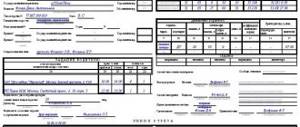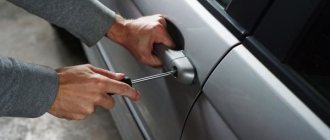Tread - wear rate
Car tires inevitably wear out over time. The wear rate of a car tread is influenced by many factors:
- operating conditions and technical condition of the vehicle;
- road surface condition, weather conditions;
- driving style;
- vehicle mileage;
- tire manufacturer;
- price range of products.
Measuring the thickness of the tread layer will allow you to accurately determine the degree of tire wear and make a timely decision to replace unsuitable tires with new ones.
The effect of tire wear on driving
Over time, the tread of car tires wears out, which invariably worsens vehicle control and significantly reduces its stability. It is known that on wet asphalt or soil, the braking distance increases if the tires are significantly worn. In this regard, many manufacturers make the tread pattern and depth in such a way as to significantly shorten the braking distance.
Also, on a wet road surface, worn-out tires can cause an accident. If the tread depth is below the permissible value, aquaplaning may occur. It occurs due to the fact that the rear and front wheels begin to rotate at different speeds. One of the front wheels ends up on the surface of the water, thereby losing traction with the road surface, causing the car to skid while driving. This may result in the driver losing control of the vehicle and causing an accident. Worn tires can cause:
- difficult control in bad weather;
- increasing braking distance on ice, snow or wet roads;
- deterioration in braking quality due to reduction in wheel weight.
You should not assume that worn-out tires only worsen vehicle performance in rainy weather and snowfall. When driving on a dry road, vehicle stability is significantly reduced (primarily this applies to vehicles without EPS systems responsible for directional stability).
Tire manufacturers pay special attention to the quality of winter tires. At the same time, depending on the type of vehicle, the tread pattern and thickness are carefully thought out, the rubber composition is selected, which together ensures the effective removal of dirt and slush from the point of contact of the rubber with the road surface, which, in turn, affects the quality of control. High-quality winter tires, even without special studs, are able to provide the necessary grip on the asphalt or soil surface.
See also: How to pay a traffic police fine if there is no receipt? 6 reliable ways
Traffic rules: for safety reasons
Different tires have different wear limits. Tread depth affects vehicle handling and road safety. According to Chapter 5 of the Traffic Regulations, maximum standards for the height of the tread pattern are established. For category M1 - passenger cars, as well as vehicles of categories N1, O1 and O2, the minimum permissible value is 1.6 mm. When operating winter tires on snowy or icy surfaces, the limit is 4 mm. A traffic police officer has the right to measure the residual depth with a verified device. If a violation is detected, a fine is imposed on the car owner.
Remaining tread depth according to traffic regulations 2021
The requirements of the traffic rules strictly limit the residual height of the working part of the ramp, upon reaching which further operation of the vehicle will be prohibited. For a more precise distinction and to avoid confusion, traffic regulations divide vehicle designs into categories based on axle load and tire thickness.
On some tire models, the manufacturer independently sets special marks (indicators), upon reaching which the tire must be changed.
The table contains the main groups of vehicles, information about what abrasion is allowed in the absence of wear indicators on the tires.
| Category | Purpose | Minimum stud height, mm |
| L | Motorcycles | 0,8 |
| N2, N3, O2, O4 | Trucks and trailers with curb weight up to 3.5 tons | 1,0 |
| M1, N1, O1, O3 | Likewise with a full wheel load of more than 3.5 tons. | 1,6 |
| M2, M3 | Large buses | 2,0 |
The maximum wear of a tire is determined according to GOST, Appendix No. 1 to the traffic rules. Here, information is deciphered in detail about under what conditions the operation of a vehicle ceases to be safe.
Summer tires
The new summer tire has an average tread depth of 7-8 mm. The service life of summer tires is, as a rule, 3-5 seasons with average mileage and moderate driving style. The legal limit on residual height is 1.6 mm. However, with 3 mm of the outer layer remaining, the car is already difficult to control, grip deteriorates, and a safety hazard arises. You should not wait to reach a critical value. Make sure to change your tires in advance.
Permissible tire tread height in Russia
Details Category: Articles Published 04/26/2020
Today we will talk about what tread height of summer and winter tires is allowed in Russia.
Tread height is one of the important characteristics of the condition of car tires. Tires are subject to natural wear and tear as they constantly experience friction during acceleration and braking. That is why the tire tread height gradually decreases.
Safe tire tread height
Modern tires are most often equipped with so-called wear indicators. These are numbers and pictograms printed directly on the tread. As wear occurs, the numbers change from higher to lower, indicating the degree of wear. Usually, a droplet symbol appears after the numbers - this means that the tire is already very worn and you need to be especially careful on wet roads. When this symbol appears, it’s time to think about replacing the tires with new ones.
Permissible tread height for summer tires
Legislative requirements for the residual tread height of tires in Russia are specified in the Technical Regulations of the Customs Union. According to this document, the minimum permissible tread height for summer passenger car tires is 1.6 mm . If the values are lower, the operation of a passenger car is prohibited and the tires must be changed.
Those who have recently passed their driving test should remember this number - it is even on the traffic police exam cards.
Permissible tread height for winter tires
Far fewer car enthusiasts know that there are separate requirements for the tread height of winter tires These requirements are also specified in the Technical Regulations of the Customs Union.
According to the regulations, the tread height of winter tires must be at least 4 mm . The same regulations state how a winter tire differs from a summer tire. So, a winter tire should have the following markings:
- "M+S";
- M&S;
- "MS";
- pictogram with the image of a mountain peak and snowflakes.
If at least one of these symbols is present, then the tire is officially considered a winter tire and is subject to requirements for a minimum tread height of 4 mm.
It’s worth remembering here that winter tires themselves have a thicker tread. So, if the tread of a summer tire has a tread height of approximately 8 mm, then the tread height of a winter tire usually reaches 10-12 mm. In addition, for winter tires, the tread height is more critical, since they are used on ice, deep snow, and slush. That is why the tread height of winter tires should be higher.
How to measure tire tread height?
The most common way to measure tire tread height is to use a caliper or ruler. However, you can use other available means if you know their sizes. For example, the tread height of summer or winter tires can be measured using a coin, if you measure the required value on the coin in advance for one or another element. Tire sellers usually use this method - in advertisements you can often find photographs of tires with a coin inserted. Thus, they show how worn the tire tread is to potential buyers.
Winter tires
Winter tires are used in harsh weather conditions: low temperatures, icy conditions, snowy road surfaces. Worn elements make the tire ineffective on slippery winter roads. Accordingly, a more serious approach to the condition of tire tread is needed. Studless friction rubber (Velcro) initially has a tread height of 8-9 mm. The new studded tire is from 9 to 11 mm; some companies produce a tread height of 12-18 mm. When the tread wears down to 4-5 mm, winter tires require replacement. In addition, the loss of more than 50% of metal studs is also a reason to change your car's shoes. The average service life of winter tires is 2-4 years.
Winter car tires
Separately, the issue of what the residual tread depth on winter tires for trucks should be was considered. There was a lot of controversy on this issue, but in the end the traffic police issued the following resolution: for winter tires on trucks, the residual tread depth must be more than 4 millimeters.
And this value should be present on absolutely any truck, regardless of which technical category it belongs to.
There is also one amendment here - to ensure safety while driving, trucks equipped with such tires must drive on such tires exclusively on snowy or icy road surfaces.
This means that if in winter the roads are mostly open, then you can also drive on such tires, but then when using them for their intended purpose, drivers may encounter problems that affect the quality of these tires.
In other words, now every truck driver in winter must strictly monitor the condition of his tires, as well as weather conditions. If tires do not meet certain values, then traffic police inspectors will have the right to apply penalties to drivers.
All-season tires
The universal all-season vehicle is used in temperate climates both in winter and summer, optimal at temperatures from +10 to -10˚C. Such tires are not suitable for use in snowfall or severe frosts. Traffic regulations allow the use of all-season tires in winter if they have special markings:
- a sign in the form of a mountain peak with a snowflake inside;
- M+S;
- M&S.
All-season tires last on average 3-4 years. In summer, when temperatures are high, all-weather tires wear out much faster. It is recommended to buy new tires when the tread layer has worn down to 2-2.5 mm.
Tread overview
The tire tread can have a different pattern to ensure the required performance characteristics. There are currently four variants of stingrays. They are designed for different road conditions and driving styles.
The symmetrical non-directional pattern remained the most popular for a long time. All applied recesses, slots and protruding parts have a mirror image relative to the center. The main advantage of such a ramp is its ease of installation: the wheel can be located on any side and rotate in any direction. The tire has the most balanced characteristics. It can provide comfort and smoothness. The production of symmetrical non-directional slopes costs less, so tires are cheaper at retail.
For the best water drainage for passenger cars, manufacturers began to produce tires with a symmetrical directional tread pattern. Such ramps are often used on dynamic and sports cars. It should be taken into account that the tire rotation must be carried out in a certain direction. It is indicated on the side of the wheel.
To give tires more characteristics, manufacturers use an asymmetrical non-directional pattern. Such slopes perform well both in rain and on dry asphalt. Sometimes all-season tires are produced with this tread pattern.
A tire with an asymmetric directional tread usually has the greatest number of qualities. Such stingrays cope well with the most difficult weather conditions. At the same time, their installation requires taking into account the direction of rotation, as well as compliance with the installation of the outer and inner parts of the wheel.
Each type of tread pattern has both advantages and disadvantages. A brief overview of the pros and cons is presented in the table below.
Table - Advantages and disadvantages of protectors.
Methods for measuring tread depth
You can estimate the remaining tread layer in various ways:
- Special volumetric indicators in the form of jumpers: if the tread layer wears down to the level of the jumpers, the tire is not suitable for further use.
- Manufacturers stamp numbers of varying depths on the surface of some types of tires. Wear is assessed visually, by the visibility of individual numbers.
- Using measuring instruments: from a metal ruler, caliper or depth gauge to an electronic tread depth gauge.
How to take measurements
At the moment, there are several ways, each driver chooses the one he likes. Please note that the measurement accuracy will vary depending on the method. Using a caliper will give you more accurate results than using a coin. But the first one is not always at hand, and not everyone knows how to use it. And the ruble can be found in almost any pocket.
Below we will tell you about the simplest, but at the same time effective methods that will really provide you with results with a minimum error.
According to wear indicator
Manufacturers made sure in advance that the driver could check the condition of the tires independently and without special equipment at any time, but this method cannot be called one hundred percent accurate. Do not forget that the declared indicators differ for some types of transport; focusing only on them is still fraught.
The indicators are small bulges and can be found in the grooves on the wheels. If the tires have already caught up with them, this means that the permissible residual height of the truck tread pattern has reached a critical level and you need to visit a service center as soon as possible. After all, in rain or snow, contact with the surface will reach only 16%, and it will not be possible to control the progress of the car in such a situation, regardless of the driver’s skills.
If the wheel is damaged or due to other reasons that do not allow you to reach the grooves, you can also focus on the side marks located opposite each other. If tactile contact is noticeable and the protrusions are felt, it means that the critical level has not yet been reached. If you don't feel any unevenness to the touch, it's time to change the tires.
According to the numbers on the contact patch
Another method from the manufacturers themselves, more visual. There are special symbols on the side of the tire that is in contact with the road surface. First of all, they are numeric, usually from 2 to 8. They are deepened to the level in millimeters that corresponds to the value of the number. If you see that the “8” has disappeared, the remaining tread value is already less than eight millimeters. The rest work the same way.
The indicator is not 100% reliable and does not show the amount of wear, but only demonstrates to what level it has reached.
In addition to numbers, there are special characters. The drop-shaped image indicates that operation will be unreliable in rainy weather. A snowflake means that driving a car in the presence of snow is strictly prohibited.
All these methods are auxiliary and signal an urgent replacement. If you need more accurate data, we recommend using the methods described below.
Our production
How to Measure Minimum Tire Tread Remaining with Vernier Calipers
- We arm ourselves with a caliper, a model with a depth gauge. Both the outdated mechanical version and the new electronic version are suitable.
- We insert the spout into the base, and rest the device itself against the pattern of the wheel.
- The resulting value is the indicator we need.
For greater accuracy, it is recommended to rest the device with some pressure, otherwise a detached particle of rubber may block the movement of the spout and the result obtained will be unreliable.
Special meter
The minimum permissible height and remaining depth of the tread pattern of new truck tires can also be studied using the device shown in the photo. It is a plastic device that resembles a caliper. It is used only to measure tire wear. To do this, there are numerical indicators and special marks on the scale and on the sides. It immediately becomes clear whether the vehicle can be used right now, how far the condition of the wheels is from the maximum standard and how long you can still drive on such tires. These devices are sold mainly in various online stores. It is better to order several pieces at once, their price is very low.
Buying tires: new or used
Old tires have become unusable, the amount of tread remaining is approaching a critical point - there is no need to take risks, it’s time for your car to change its shoes. Do you want to spend little money and buy used tires? Be careful! Sellers indicate in their advertisements the condition of used tires as good or excellent. Don’t be too lazy to measure the height of the tread layer yourself. And remember: for winter tires, a value of 4 mm is already 100% wear. The quality of domestic roads, unfortunately, does not allow tires to be used for 7-10 years. Purchasing used car tires is always a risk of buying products with extreme wear.
Don't skimp on safety. Buying new tires will require a larger investment, but will pay off with a long period of trouble-free operation.
Penalty for tires with inappropriate tread depth
Since the safety of all road users depends on the condition of the car’s tires, regulatory authorities have special requirements for the quality of tires. Sanctions are provided for violation of the tread depth, cuts and other damage. It is prohibited to install tires from different manufacturers with different patterns and tread heights on a vehicle.
Article 12.5 of the Code of Administrative Offenses of the Russian Federation establishes a list of preventive measures imposed when various malfunctions of a vehicle in use are detected. Such faults also include poor condition of tires. The driver faces a warning for the first time, and a fine of 500 rubles for a repeated violation.










